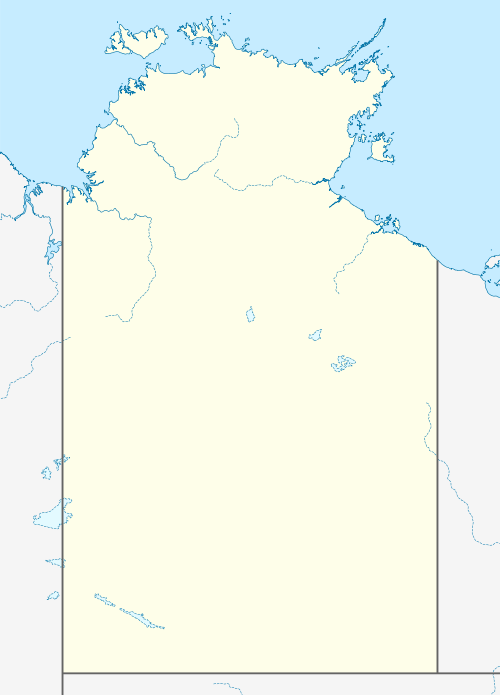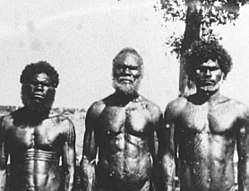Bathurst Island (Northern Territory)
Bathurst Island (2,600 km2 or 1,000 sq mi,[1] 11°35′S 130°18′E) is one of the Tiwi Islands in the Northern Territory off the northern coast of Australia along with Melville Island.
 Tiwi Islands | |
 Bathurst Bathurst Island (Northern Territory of Australia) | |
| Geography | |
|---|---|
| Location | Timor Sea |
| Coordinates | 11°35′S 130°18′E |
| Archipelago | Tiwi Islands |
| Major islands | Bathurst, Buchanan |
| Area | 2,600 km2 (1,000 sq mi) |
| Administration | |
Australia | |
| Territory | Northern Territory |
| Largest settlement | Wurrumiyanga (pop. 1582) |
| Demographics | |
| Population | ca. 1640 |
| Pop. density | 0.63/km2 (1.63/sq mi) |
Description
The largest settlement on Bathurst is Wurrumiyanga (known as Nguiu until 2010), in the south-east, with a population of around 1,450.[2] Located on the south east corner of Bathurst Island, Wurrumiyanga is approximately 70 km (43 mi) north of Darwin. The second largest settlement is Wurakuwu, with a population of 50, located 60 km (37 mi) northwest of Wurrumiyanga. The third settlement on the island is a small family outstation called 4 Mile Camp, about 6 km (3.7 mi) west of Wurrumiyanga.
History

Aboriginal Australians have occupied the area that became the Tiwi Islands for at least 40,000 years.[3]
On 5 May 1623, Willem Jootszoon Van Colster (or Coolsteerdt), in the ship Arnhem named the island De Speult Eylandt, in honour of Herman van Speult, Governor of Ambon, who had commissioned the voyage of exploration.[4]
In 1828, the island was named Bathurst Island by Scottish explorer John Clements Wickham, after the explorer Phillip Parker King's ship which had explored the area in August 1821. He named the island during a voyage in March 1838 when he was second in command of HMS Beagle in Charles Darwin's expedition. The ship's name honours Henry Bathurst, 3rd Earl Bathurst, (1762-1834), former British Secretary of State for the Colonies.
From 1910 to 1938 the island was the site of the Roman Catholic mission of Francis Xavier Gsell, known as the "Bishop with 150 wives" for his practice of "buying" girls betrothed to older men, thus making it possible for them to marry men of their own age.
On 24 December 1912 the whole island was proclaimed an Aboriginal reserve, under the Northern Territory Aboriginals Act 1910. A series of documents shows that previous to the proclamation (published in the Commonwealth Gazette on 18 January 1913), there had been discussion about two parcels of land on the island. One was the allocation of 10,000 acres (4,000 ha) allocated to the Mission, which would continue on annual leases, and the second regarding 10,000 acres (4,000 ha) which was previously allocated as Crown Land under the Northern Territory Tropical Products Act 1904, for the production of cotton and other tropical crops. The correspondence shows that this was decided to be undesirable from the point of view of the Aboriginal people, both because of the bad influence of white men and the need to import labour to use on the leases.[5]
During the Bombing of Darwin the first wave of 188 Japanese planes was spotted by Father John McGrath, a Catholic priest conducting missionary work at the mission station on Bathurst Island. Father McGrath sent a message on the radio saying "An unusually large air formation bearing down on us from the northwest". Nearly everyone ignored this, though it was on the most popular radio station. About an hour later there were roughly 100 people dead, but the people who followed his instruction all survived. Darwin received both this and another warning at least twice by radio, no later than 9:37 a.m. However, 10 US P-40E Kittyhawk fighters were returning to Darwin after aborting a mission to Timor due to bad weather,[6] and the Australian duty officer assumed this was the same formation. The warnings were not acted upon so, as at Pearl Harbor two months earlier, Darwin's final chance to make last-minute preparations for the impending raid slipped away.
In film
Bathurst Island was depicted as Mission Island in the 2008 Baz Luhrmann film Australia. In the film, the mixed-race boy Nullah is kept at the mission on the island for the two months preceding the Bombing of Darwin. The mission is bombed in the raid, and the children hide from Japanese troops until their rescue. The presence of Japanese troops on the island is entirely fictional, as no such landing by the Japanese was made during World War II. There was only a Japanese plane that crashed on the island where the pilot was caught and handed over to the correct authorities.
Notable people
Notes and references
- "Size change". Encyclopædia Britannica entry on Bathurst island supporting size.
- "Nguiu". Tiwi Islands Local Government website. Archived from the original on 9 December 2004.
- "Timeline: Dreamtime to 1978". Tiwi Land Council. Retrieved 4 February 2020.
- "Beyond Darwin: Tiwi Islands". Pocket Oz Travel and Information Guide: Darwin. Retrieved 4 February 2020.
- "Bathurst Island - Reserve for Aborigines.[56pp] (1904-1939)". National Archives of Australia. Record search on item barcode 46584, Control symbol 1938/33126, Citation NAA: A1, 1938/33126. Retrieved 4 February 2020.CS1 maint: others (link)
- "The Bombing of Darwin". The Battle for Australia 1942. 19 February 1942. Retrieved 4 February 2020.
Further reading
- "Bathurst Island Mission 1911-1938-1978)". German missionaries in Australia. Griffith University.
- "Bathurst Island Mission (1911-1974)". Find and Connect.
- Bathurst island (Encyclopædia Britannica)
- Bathurst Island (Walkabout)